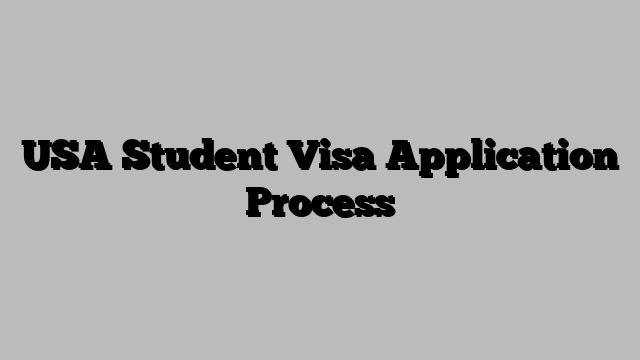USA Student Visa Application Process

The United States remains one of the top destinations for international students pursuing higher education. With world-renowned universities, research opportunities, and access to global networks, studying in the U.S. can be a life-changing decision. However, before you pack your bags, there’s one major step you must complete: the student visa application process.
Whether you’re from Nigeria, India, Kenya, or any part of the world, this guide breaks down the USA student visa application process in 2025—step by step, with requirements, costs, documents, interview tips, and frequently asked questions.
What Is a USA Student Visa?
A U.S. student visa is an official document that allows foreign nationals to enter the United States to pursue academic or vocational studies. There are three main categories:
| Visa Type | Purpose |
|---|---|
| F-1 Visa | Academic studies at U.S. colleges/universities or English language programs |
| M-1 Visa | Non-academic/vocational studies (e.g., technical schools) |
| J-1 Visa | Exchange visitor programs (includes study, internships, training) |
Most international students apply for the F-1 visa, which covers full-time programs at accredited institutions.
Step-by-Step: USA Student Visa Application Process
Step 1: Apply and Get Accepted by a SEVP-Approved School
Before you can apply for a student visa, you must be accepted by a SEVP-certified (Student and Exchange Visitor Program) institution in the U.S.
Tips:
- Apply to multiple schools to increase your chances
- Choose accredited universities that can issue Form I-20
- Most schools require standardized test scores (SAT, GRE, TOEFL, IELTS)
Once admitted, the university will issue your Form I-20 (for F-1/M-1) or DS-2019 (for J-1).
Step 2: Pay the SEVIS I-901 Fee
After receiving your I-20 or DS-2019, you must pay the SEVIS fee to register in the Student and Exchange Visitor Information System.
| Visa Type | SEVIS Fee |
|---|---|
| F-1 / M-1 | $350 |
| J-1 | $220 |
Payment site: fmjfee.com
Keep the receipt! You will need it for your visa interview.
Step 3: Complete the DS-160 Visa Application Form
The DS-160 is the U.S. Department of State’s online Nonimmigrant Visa Application Form.
- Website: ceac.state.gov
- Upload a passport-sized photograph (2×2 inches, white background)
- Print the DS-160 confirmation page with barcode
You will need:
- Your passport
- Form I-20/DS-2019
- SEVIS fee receipt
- Travel plans and U.S. contact details
Step 4: Pay the Visa Application Fee
You must pay a non-refundable visa application fee (MRV Fee).
| Fee | Amount |
|---|---|
| F-1 / M-1 / J-1 | $185 USD |
Payment methods depend on your country (e.g., GTBank in Nigeria, Mpesa in Kenya, etc.)
Keep the payment receipt, as it’s required to book your visa interview.
Step 5: Schedule and Attend the Visa Interview
Next, create an account on your local U.S. Visa Appointment website and schedule your visa interview at the U.S. embassy or consulate in your country.
You’ll need:
- DS-160 confirmation
- MRV receipt
- Passport
- Form I-20/DS-2019
- SEVIS receipt
Some countries may require a biometric appointment before the interview.
Step 6: Attend the Student Visa Interview
Your visa interview is the most important part of the process. Be honest, prepared, and confident.
Common Interview Questions:
- Why do you want to study in the U.S.?
- Which university are you attending and why?
- Who is sponsoring your education?
- What are your plans after graduation?
- Why not study in your home country?
Documents to Bring:
- Valid passport (6+ months validity)
- Form I-20/DS-2019
- DS-160 confirmation page
- SEVIS receipt
- Visa appointment confirmation
- Academic transcripts and test scores
- Financial documents (bank statements, sponsor letter, scholarship details)
Optional (but helpful):
- Proof of home ties (family, property, job offer, etc.)
Step 7: Visa Approval and Passport Pickup
If approved, the visa officer will keep your passport and return it in 3–10 business days with your F-1, M-1, or J-1 visa stamp.
If denied, you’ll receive a letter explaining the reason (usually under Section 214(b) for lack of ties to your home country or financial proof).
Step 8: Travel to the U.S.
You can enter the U.S. up to 30 days before your program start date (printed on your I-20).
At the port of entry:
- Present your passport, visa, and I-20
- CBP officer will issue your I-94 Arrival/Departure Record
Timeline of the Student Visa Process
| Task | Timeline |
|---|---|
| Apply to university | 6–12 months before start |
| Get I-20 or DS-2019 | 1–3 months |
| Pay SEVIS fee | Immediately after receiving I-20 |
| Complete DS-160 | Same week |
| Schedule visa interview | 2–6 weeks wait time (varies by country) |
| Attend interview | 1–2 months before travel |
| Visa approval and return | 3–10 days |
Start early to avoid last-minute stress.
Financial Requirements
You must show proof of sufficient funds to cover:
- Tuition fees (1 year minimum)
- Living expenses ($10,000–$15,000/year)
- Travel and insurance costs
Acceptable proof:
- Personal or sponsor bank statements
- Affidavit of support
- Scholarships or assistantships
- Education loans
Can I Work on an F-1 Visa?
Yes, with restrictions.
| Type of Work | Allowed? | Conditions |
|---|---|---|
| On-campus | Yes | Up to 20 hours/week during school |
| Off-campus (CPT) | Yes | Must be authorized and related to field |
| Optional Practical Training (OPT) | Yes | 12 months after graduation (24-month extension for STEM) |
Can I Bring My Family?
Yes. Your spouse and children can apply for F-2 (or M-2/J-2) dependent visas.
F-2 Dependents:
- Cannot work
- Can study part-time (spouse) or full-time (children)
Cost Breakdown of the Student Visa Process
| Item | Estimated Cost (USD) |
|---|---|
| University application fees | $50–$150 per school |
| English tests (TOEFL/IELTS) | $180–$250 |
| SEVIS Fee (F-1) | $350 |
| Visa Application Fee | $185 |
| Passport Photos | $10–$20 |
| Medical insurance (U.S.) | $600–$2,000/year |
| Airfare | $700–$1,500 (depending on location) |
Real-Life Case Study: Mariam from Kenya
- University: University of Texas at Austin
- Program: Master’s in Public Health
- Funding: Partial scholarship + family support
- Visa Outcome: Approved on first attempt
Tip from Mariam:
“The visa officer asked me why I chose the U.S. I showed them how my course wasn’t available at home and explained my long-term career goals in Africa. I carried all my documents, and they didn’t even ask to see most of them.”
Rejected Visa? What to Do Next
Common rejection reasons:
- Lack of financial proof
- Weak academic profile
- Poor interview performance
- Doubtful intent to return home
Next Steps:
- Review your rejection letter
- Fix the issues (better documents, clearer answers)
- Reapply with improved preparation
There is no waiting period to reapply, but rushing without improvement will likely lead to another refusal.
Final Thoughts
The USA student visa application process may seem long and detailed—but it’s very achievable with proper planning and honesty. Make sure your documents are in order, you have genuine academic intent, and you can clearly express your goals during your interview.
With a valid visa, you’ll have access to world-class education, internship opportunities, research, and a future that may even lead to U.S. work authorization or a green card.
Call to Action
Are you ready to study in the U.S.?
- Start applying to SEVP-approved universities now
- Gather your financial and academic documents
- Prepare thoroughly for your student visa interview
- Consult with your school’s Designated School Official (DSO) for guidance
Education in the United States is more than a degree—it’s a door to global impact.




